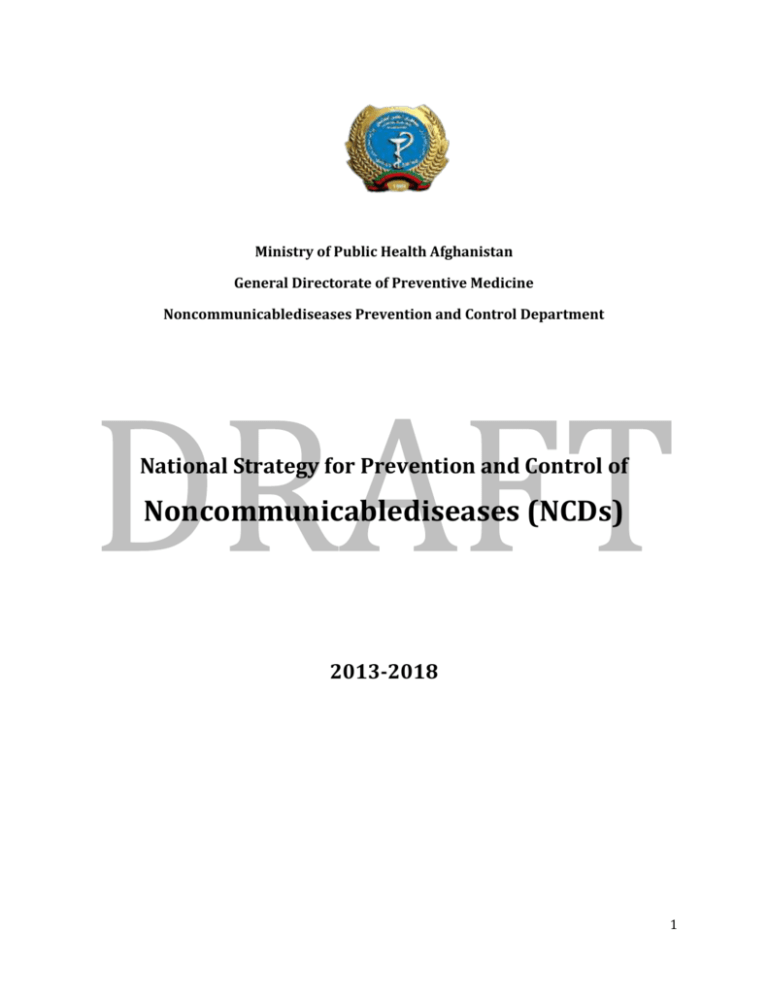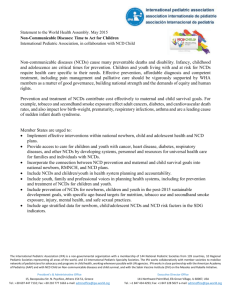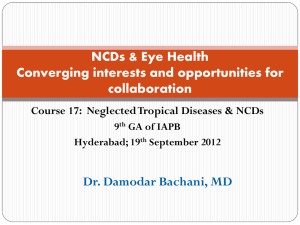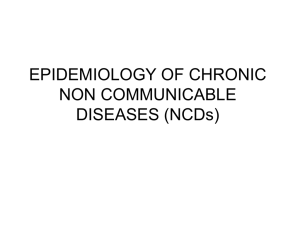Strategic Objective 1
advertisement

Ministry of Public Health Afghanistan General Directorate of Preventive Medicine Noncommunicablediseases Prevention and Control Department National Strategy for Prevention and Control of Noncommunicablediseases (NCDs) 2013-2018 1 TABLE OF CONTENTS FORWARDS 3 ACKNOWLEDGMENT 4 ABBREVIATIONS 5 INTRODUCTION 6 SITUATION ANALYSIS 7 RELEVANCE TO NATIONAL AND INTERNATIONAL DOCUMENTS 9 CORE VALUES AND PRINCIPLES 10 POLICY STATEMENT 10 VISION 10 MISSION 10 STRATEGIC OBJECTIVES 11 STRATEGIC APPROACHES 12 RELEVANT STAKEHOLDERS 16 INSTITUTIONAL ARRANGEMENTS 16 NATIONAL LEVEL PROVINCIAL LEVEL COMMUNITY LEVELS 16 17 18 MONITORING AND EVALUATION FRAMEWORK 18 2 FORWARDS Minister of Public Health 3 ACKNOWLEDGMENT By Director General Preventive Medicine 4 ABBREVIATIONS BCC Behavior Change Communication BPHS Basic Package of Health Services CVD Cardio-vascular Disease EPHS Essential Package of Hospital Services MCC Millennium Challenge Corporation NCDs Noncommunicable Diseases NGO Non-governmental Organization RTI Road Traffic Injuries DALYs Disability Adjusted Life Years NGOs Non-Government Organizations WHA World Health Assembly WHO World Health Organization YLD Years of Life Lost due to Disability COPD Chronic Abstractive Pulmonary Disease MDG Millennium Development Goals, 5 INTRODUCTION The development of the National Noncommunicable Diseases Strategy is an expression of the Ministry of Public Health (MOPH) Afghanistan’s commitment to enhancing the quality of life of the Afghan population through addressing the burden of noncommunicable diseases. This document will help the MoPH to direct its efforts and resources toward decreasing the health and socioeconomic consequences of noncommunicable diseases. Evidence, including from the Afghanistan mortality survey (AMS), identifies the increasing mortality due to the major NCDs and injuries, which have a major impact on the health of communities, the health system, and the economy of Afghanistan, as a major challenge. The determinants of noncommunicable diseases are multi-factorial and often are outside the control and influence of the health sector. The four main groups of noncommunicable diseases share four main risk factors: tobacco use, unhealthy diet, harmful use of alcohol and insufficient physical activity. To reduce these risk factors, changes in the lifestyles and behaviors of individuals and families is necessary. Because of the communal nature of the Afghan society, there is a need for interventions in community settings to be at mosques, villages, schools or workplaces, to promote and encourage healthy behaviors to prevent noncommunicable diseases. Moreover, the prevention, detection and management of noncommunicable diseases are important to decrease suffering and reduce deaths from the mentioned diseases. These all can be done through a coordinated multisectoral national response. The Afghan MoPH, as the steward of health sector, has assumed the responsibility to tackle the burden of noncommunicable diseases, in view of the demographic and epidemiologic transition envisaged in the near future. The MoPH has taken some steps toward initiating a comprehensive response to noncommunicable diseases. Establishment of the Department of Noncommunicable Diseases within the structure of the MoPH is an important first step in this regard. The department, since its initiation, has prepared a vision to tackle noncommunicable diseases through evidencebased interventions adapted to the local context and situation. Development of a national noncommunicable diseases strategy is an indispensable step, which provides clear guidance to the department on priority interventions and actions to take in order to reduce the burden of these diseases and improve the quality of life for the people of Afghanistan. The interventions outlined in this document will guide many public and private sector individuals and organizations involved in the prevention, and control of noncommunicable diseases. Having a National NCDs Strategy and Key Strategic focus areas supported by Action Plans, is essential for ensuring that strategies and guidelines are in place for the prevention and control of noncommunicable diseases in Afghanistan. This NCD Strategy also reinforces the Government of Afghanistan and the Ministry of Public Health’s commitment to regional and international initiatives such as: • • • • The Political Declaration of the High-Level Meeting of the UN General Assembly on the Prevention and Control of Noncommunicable Diseases, September 2011 The Global Action Plan for the Prevention and Control of Noncommunicable Diseases 2013-2020, approved by the World Health Assembly in May 2013 Other WHO related strategies and plans of action ( DPAS, Tobacco , Nutrition , etc) Alma Ata and Primary Health Care Declaration 1978 6 SITUATION ANALYSIS Background: Non-communicable diseases (NCDs) consist of a vast group of non-infectious medical conditions, but in terms of premature mortality, emphasis has been on cardiovascular disease, cancer, diabetes, and chronic respiratory diseases. Although NCDs were not in the global agenda when the United Nations developed the Millennium Development Goals (MDGs), however it has raised concerns and has culminated in the United Nations (UN) resolution on Political Declaration of the High-level Meeting of the General Assembly on the Prevention and Control of Non-communicable Diseases in September 2011. This special session placed NCDs on the global development agenda (1). Later on in 2012, the World Health Assembly endorsed an important new health goal to reduce avoidable mortality from NCDs by 25% by 2025 which is called the 25 by 25 goal (2). To achieve the target of 25% reduction in preventable deaths health systems and strategic framework need to be transformed to provide sufficient care for both communicable and NCDs in Afghanistan. Global Health and Economic Burden: In 1990, there were 26·6 million deaths worldwide from NCDs increasing in 2010 to 34·5 million (3). Likewise the global burden of NCDs has increased from 43% (1·08 billion of the total 2·50 billion) in 1990, to 54% (1·34 billion of 2·49 billion) of the total number of disability-adjusted lifeyears in 2010 (4). Furthermore in 2008, around 57 million deaths were reported globally, of which 36 million (or 63%) were due to NCDs. The most common NCDs contributed to global deaths were cardiovascular diseases, diabetes, cancer and chronic respiratory diseases. Of the total NCDs deaths globally, nearly 80% occur in low-and middle income countries (5). Likewise the global economic burden of NCDs is large, estimated at US$6·3 trillion in 2010, rising to $13 trillion in 2030. A 10% rise in NCDs leads to a 0·5% decrease in gross domestic product (6). Due to quick demographic and epidemiological transitions in South Asia life expectancy is increasing and fertility rate is reducing which has leaded to increased health burden of NCDs with 46 percent (55percent including injuries) of burden of disease as a proportion of total forgone DALYs (7). It has been indicated that prevalence of smoking varies in South Asian countries from 16-32%, alcohol consumption between 3-41%, eating less than 5 servings of fruits and vegetable 81-99%, physical inactivity 4-24%, overweight and obesity 9-44%, raised blood pressures 8-42%, raised fasting blood sugar 4-9%, and raised blood cholesterol 13-54% (8). In neighboring Iran a systematic analysis of studies from 1996 to 2004 estimated that the overall prevalence of hypertension in 30 – 55 and >55-year-old population were around 23% and 50%, respectively. The prevalence in men was 1.3% less than that in women (9). In a study in Pakistan eastern neighboring country the overall prevalence of hypertension was 26%, with differentiation in males (34%) versus females (24%). Age analysis revealed that the prevalence of hypertension increased with age and hypertensive subjects were 5.6 times more likely to be over 35 years of age (10). 7 Burden of NCDs in Afghanistan: As Afghanistan is in the early stages of the demographic transition therefore the burden of NCD is adding up to the ongoing burden of communicable diseases, causing a double disease burden on the population. The transition will become more evident in the years to come. According to predictions the proportion of the population 65 years and older will increase from 2.1 percent, in 2000, to 2.9 percent, in 2025. Source As older populations are more likely to be affected by NCDs, the health burden from NCDs will rise in parallel with population aging. In 2004, NCDs (inclusive of injuries) accounted for 46 percent in terms of the number of lives lost due to ill health, disability, and early death (DALYs), with the remainder from communicable diseases and maternal and child health issues. Due to less attention to NCDs and years of conflict information of burden of morbidity and mortality contributed by NCDs is not fully available in Afghanistan. Nonetheless, the total DALYs forgone attributed to NCDs in Afghanistan is estimated to be 43% (8). Afghanistan Mortality Survey (AMS) 2010 revealed that 33.3% of all deaths in Afghanistan are attributed to NCDs compare to 42.6% of all together cause of death due to communicable, maternal, prenatal, and nutrition conditions. Cardiovascular diseases, malignant neoplasm, diabetes, respiratory diseases, and digestive diseases are the leading cause of deaths due to NCDs, which account 14%, 7.3%, 3.7%, 1.9%, and 1.8% of total NCDs deaths, respectively (10). Based on a World Health Organization (WHO) estimates, in 2000 there were 468,000 people with diabetes in Afghanistan. This number is expected to rise to 1,403,000 in 2030, representing nearly a threefold increase when compared to 2000(11). The prevalence of Diabetes among population of 20-79 years have been estimated for Afghanistan in which according to adjustment of national population the prevalence is 6.6% and 7% for 2010 and 2030, however after the world population adjustment the prevalence for 2010 is estimated 8.6% and for 2030 it is projected to be 9.9% (12) Likewise little is known about the prevalence of risk factors of NCDs in Afghanistan, yet. However in a study among men 15 years and older in Kabul city revealed that the prevalence of smoking is 35% (13). Moreover in a study with the aim of identifying the prevalence and risk factors of NCDs among adult population (≥40 years) in urban portion of Kabul city in 2012, it was revealed that the prevalence of Diabetes Mellitus was 13.27% (14), obesity with BMI≥ 30 was 31.2% (15) and prevalence of hypertension was 46.2% (16). The prevalence of factors among study subjects were: current smoking (5%), snuff users (8.9%), using solid fat in kitchen (69%), frequency of taking 3 times or less vegetable and fruits per week (58%). In addition, an assessment of air quality of Kabul city revealed the ambient air quality in the city has deteriorated to such extend that it can be ranked among the dirtiest cities in the world which potentially increase the burden of respiratory diseases and different types of cancer among human (17). 8 Response to noncommunicable diseases Despite the burden of NCD, these diseases have ranked very low among government and donor priorities. There has not been any national policy, strategy, targets or coordinating body for NCDs so far in the health sector of Afghanistan. Most of the development projects in health have been constituted on the basis of the MDGs, which do not include NCDs as a development issue. Other than a number of basic discussions NCDs have not been discussed in high-level debates between MoPH and the development partners, including the donor agencies. The Afghan health system faces a general shortage of health-care professionals, particularly in rural areas, which particularly makes it difficult to effectively implement NCDs preventive interventions. Capacity is lacking at the primary and secondary health care levels for control and management of NCDs. Furthermore, management of NCDs is not considered in capacity building trainings of health providers of primary health-care working at the BPHS facilities. The national NCDs surveillance system, which is crucial for informed policy and strategy, has not been established yet. Currently the surveillance for NCDs has been very limited. Mechanism for death registration and the qualification of the cause of death information does not exist. Data pertaining to behavior risk factors are not available, except for tobacco use among youth and for mental health. Many NGOs collect health information and most participate in quality assessment evaluations. In order to gain and maintain contract extension/renewals for health services delivery. However none of the elements is particularly focused on NCDs. Despite the importance of noncommunicable diseases in terms of share of death factors among Afghan population and sound evidence that NCDs pose high risk to health and economic condition of the people very little has been spent on NCDs prevention and control. No effective program or intervention has been developed or financed through public system in the country through government or donors funding. Almost no fund raising activities have been carried out to support NCD related activities in the country. RELEVANCE TO NATIONAL AND INTERNATIONALPOLICIES In the development of this strategy efforts were made to have it in line with national and global policies prepared based on evidence. During the consultative work for the development of this strategy national and international literature and documents were reviewed and were used to enrich this strategy. The MoPH strategic plan for 2011-2015 identified noncommunicable diseases as a major challenge to health of the Afghan people. The recent health policy for 2012-2020 also identified NCDs as important health issue and therefore, included a policy statement for the control of NCDs, which guides this document. Moreover, the strategy was guided by the WHO’s Global Action Plan for the Prevention and Control of Noncommunicable diseases2013-2020. 9 CORE VALUES AND PRINCIPLES This strategy is in line with the core values and principles outlined in the National Health and Nutrition Policy 2020 of the MoPH that include: 1. Right to Health 2. Right to nutrition 3. Partnership and Collaboration 4. Equity 5. Community Participation and ownership 6. Evidence-based decision-making 7. Promoting Results-oriented culture 8. Quality 9. Transparency and accountability 10. Sustainability 11. Dignity and Respect 12. Gender POLICY STATEMENT The Ministry of Public Health considers the integration of Noncommunicable Diseases (NCDs) such as prevention and control of cardiovascular diseases, diabetes, and chronic pulmonary diseases in the BPHS and EPHS. Furthermore, building capacity of service providers on the prevention, diagnosis and treatment of NCD and modify the infrastructure as needed for NCDs improving management. Our focus will not only be on prevention of NCDs but also on improving diagnosis and management of the NCDs at the various levels of health care facilities. VISION The overall quality of life of the Afghan people is enhanced through minimizing the burden of noncommunicable diseases and their complications MISSION The strategy guides the health system and non health sectors towards the reduction of the burden of noncommunicable diseases and ultimately improvement of quality of life for all Afghans, which will be achieved through collaborative and comprehensive efforts led by MoPH working with its partners and stakeholders. Goal Prevent or delay the onset of noncommunicable diseases and their related complications, and improve their management, thus enhancing the quality of life of the Afghan population, leading to longer and more productive lives. 10 STRATEGIC OBJECTIVES The national noncommunicable disease strategy identifies a number of specific strategic objectives. The achievement of these objectives requires leadership by the MoPH working in close collaboration with the relevant governmental and development partners. The objectives spell out prioritized areas in the context of Afghanistan that are considered to have important impact on the health and well-being of the population. The relevant MoPH departments will be mobilized to contribute to achieving the objectives of this strategy. The strategic objectives are inspired by the national context and are based on the burden of noncommunicable diseases as well as the global recommendations such as the WHO’s global action plan on noncommunicable diseases. The strategic objectives are explained briefly below: Strategic Objective 1 To advocate for and raise NCDs priority as well as integrate NCD in the development work at national level During past years noncommunicable diseases were left out of the development agenda of the MoPH and stakeholders. This was mainly due to other priorities being identified by the MoPH such as maternal and child health and communicable diseases and lack of evidence on the significance of NCDs. With the recent evidence on magnitude of the burden of NCDs in Afghanistan there is need to inform key stakeholders and attract their support for the implementation of evidence based interventions for the prevention and control of NCDs. Strategic Objective 2 To introduce interventions through which the main shared, modifiable risk factors for NCDs are reduced. Taking to consideration the significant contribution of risk factors, such as tobacco use, unhealthy diets, insufficient physical activity and harmful use of alcohol, to the increased levels of noncommunicable diseases in the population the MoPH will identify best practices and evidence based interventions to reduce the mentioned risk factors and eventually prevent and control noncommunicable diseases. Strategic objective3 To strengthening national health systems response and strengthen NCD integration in PHC In order to address NCD there is need for an effective and strong response from health system. Institutional and organizational measures have to be taken to respond to the huge burden of these diseases and conditions. All building blocks of the health system have to be strengthened in order to generate a proper response. In order to involve various layers of health workers in the response there is a strong need to integrate NCD into primary health care package namely the BPHS. 11 Strategic Objective 4 To strengthen the evidence base for the prevention and control of NCDs In order to design and implement effective interventions for the prevention and control of the NCDs, comprehensive and reliable data is needed. The MoPH will strengthen NCD surveillance and promote research in the area of NCDs. More specifically, the MoPH will establish a surveillance system that follows the recommended WHO framework for surveillance with its three components of exposures, outcomes of the noncommunicable diseases that are of public health importance, and health system response. Strategic Objective 5 To promote partnerships for the prevention and control of NCDs Prevention and control of NCDs warrant strong partnership among all relevant stakeholders including government ministries and development partners. Effective mechanisms to boost partnership for the prevention and control of NCDs will be identified and introduced such as interministerial coordination and coordination with donor agencies and implementing partners as well as civil society. Strategic Objective 6 To monitor implementation of the NCDs prevention and control interventions and evaluate progress at the national level Progress towards implementing the interventions for NCD prevention and control will be regularly monitored through establishing a monitoring and evaluation framework at national level. Moreover, interventions will be evaluated at different stages for effectiveness, relevance, efficiency and sustainability. STRATEGIC APPROACHES In order to achieve the strategic objectives depicted in the document a number of strategic approaches and related strategic interventions are set which guides the implementation. The strategic approaches are in line with the objectives mentioned in the early section. Strategic Approach 1 Advocacy and work with decision makers NCD need to be on the top of agenda considering its burden on population health. The first step is to make it a priority for the health system. Support from key stakeholders and decision makers are essential for successful implementation of NCDs interventions. Advocacy is a key tool in attracting support to important health interventions. There is need to a systematic plan based on which advocacy will be done with key governmental and nongovernmental decision makers. In order to implement the strategy financial resources need to be allocated by both government and donor agencies. 12 Key Interventions 1. Develop and implement effective advocacy plans for NCDs and launch campaigns for NCDs prevention and control. 2. Actively advocate to national, provincial and local community leaders, and other partners (e.g. industries), to enhance their awareness of the magnitude of the NCDs burden and to engender their commitment for instituting effective measures to prevent and control chronic diseases Strategic Approach 2 Prevention and Promotion of noncommunicable diseases Health promotion continues to play a pivotal role in the prevention of NCDs. Media and social marketing to promote healthy lifestyles and to increase knowledge and awareness of NCDs risk factors will be strengthened. Workplace-based and community-based demonstration programs to empower individuals at high risk or with chronic diseases to develop health literacy take on selfcare responsibilities and become a resource for themselves and others in disease prevention and management will be tailored and piloted. NCDs prevention and control interventions will be incorporated into the Basic Package of Health Services (BPHS) and Essential Package of Hospital Services (EPHS). In close coordination with the Health Promotion department of MoPH and other stakeholders, effective health promotion interventions will be elicited, piloted and implemented throughout the country. Key Interventions 1. Creating content for health promotion addressing the main risk factors of NCDs; unhealthy eating and physical inactivity 2. Intensifying media campaigns using television, radio and printed media for dissemination of tailor made IEC/BCC material on NCDs 3. Strengthening of the Workplace-based Health programs, in both health education and health-promoting activities 4. Promote Population based interventions 5. Working with relevant government agencies such as traffic police and others to decrease risks of road traffic injuries and other unintentional injuries Strategic Approach 3 Strengthen health system focusing on NCD integration in PHC MoPH recently established a noncommunicable diseases department. Although this is a good start but further strengthening of the department will ensure successful implementation of this strategy. Capacity inside MoPH regarding the NCDs should be built at different levels. There is a need to continually improve the skills, knowledge and attitude of all health care personnel, both in primary care and hospital settings, to deal with the challenge of chronic disease management. This can be done through continuous professional development training courses, conducted especially at the local level. Availability of trained health care providers is critical to support successful implementation of NCDs management programs. The required guidelines and protocols will be 13 prepared to enhance management of the NCDs at different levels of the health care in Afghanistan. Further work should be done with other departments relevant to the cause of NCD control at MoPH in order to create a holistic health system response to these diseases. Key Interventions 1. 2. 3. 4. 5. 6. 7. Organizational strengthening of the NCD department Mobilize financial resources for evidence based NCD control interventions Enhance quality of medicine for treatment of NCD Integrate control and management of NCD into BHPS and EPHS Develop and implement capacity building plans for the national NCDs team at all levels Development of health education programs at all MoPH health care facilities. Development of self-guided intervention packages to integrate NCD in PHC and to help patients with NCDs and its risk factors and their families to monitor and manage their disease or condition. 8. Build capacity of health care providers in prevention of NCDs and interpersonal communication with patients 9. Empowering communities to have more control on their health through creation of community based groups for prevention of NCDs Working on aligning the structure of NCDs department within the MoPH with requirements for implementation of the NCDs strategy Strategic Approach 4 Strengthen generation of evidence for enhance control of NCD Research and surveillance serve an important function across the intervention pathway for NCDs prevention and control. Research into the economic costs of NCDs, the cost- effectiveness and costbenefits of prevention strategies, and other health economics analyses provide powerful arguments for instituting policy and regulatory interventions to reduce NCDs burden. Prevalence studies for both risk factors and chronic diseases conditions provide critical information on which to base priority setting and the selection of specific population and clinical interventions for particular communities and target groups. Surveillance data, collected over time, also give an indication of the effectiveness of interventions on population risk factor and disease end-points. Evaluation studies complement surveillance data by examining efficacy, cost-effectiveness and impact more thoroughly. Behavioral studies and applied research, including community-based participatory research, result in greater understanding of the behavioral change process, which is fundamental to prevention. Medical studies offer the evidence base for clinical approaches to disease management. For greatest utility, research across communities and countries should utilize standardized methodologies, instruments, and indicators, to permit comparisons and broad applicability of lessons learned. Key Interventions 1. Establishing a National Diabetes Registry. 2. Establishing National Cancer Registry 3. Conduct the STEPS survey to develop Nation-wide data on NCDs& Risk Factor e, looking at selected NCDs and NCDs risk factors amongst Afghan. 14 4. Establish national monitoring framework for NCD surveillance including national targets & indicators and integrate in health information system 5. Encourage research in Diabetes, Obesity and NCDs risk factors, including aspects of health economics of population-based interventions, Novel approaches for behavioral modification and Novel approaches for clinical management Strategic Approach 5 Secure support from all Partners Population-based lifestyle interventions require a ‘whole-of-society’ response. Partnerships and community mobilization are essential to ensuring acceptance and popular support for NCDs prevention and control. The underlying determinants of NCDs are outside of the exclusive purview of the health sector, and partnerships across sectors are necessary to effectively address these determinants. Resources for prevention and control are limited; partnerships and collaboration can facilitate resource leveraging to augment national health budgets for chronic diseases. Furthermore, policy and population based interventions require the cooperation and acceptance of society. Finally, empowering communities and individuals to fully participate in health decisionmaking is very important in the control and prevention of chronic diseases. Key Interventions: 1. Establish multi-sectorial partnerships and encourage stakeholder participation in developing, implementing and evaluating NCDs prevention and control interventions. 2. Establish positive partnerships with all relevant stakeholders for the implementation of programs and activities at national level 3. Create collaboration with the food industries (including food technologists and retailers) to increase the production and promotion of low fat, low salt and low sugar foods. 4. Intensify physical activity programs in the community e.g. brisk walking& exercise groups. 5. Establish partnerships with the media and advertising industries to promote the messages of healthy eating and being active, together with factual information on obesity and weight reduction. 6. Work continuously with donor agencies to secure funding for implementation of prioritized NCDs interventions and activities Strategic Approach 6 Monitoring for better results Regular and systematic monitoring of NCD interventions adds value to implementation of the strategy. In order to ensure effective implementation of the interventions stipulated in this strategy, there is need for a detailed monitoring and evaluation plan which will identify key indicators and timeline for implementation. Key Interventions 1. Develop monitoring and evaluation tools for NCDs in line with the objectives of the strategy 2. Implement a national monitoring and evaluation plan for NCD control 15 RELEVANT STAKEHOLDERS The MoPH, considering the current multiplicity of stakeholders, is committed to work in close coordination with the relevant stakeholders. Support of all relevant stakeholders will be secured through complimentary and positive partnership. All relevant stakeholders will be actively involved at various stages of implementing the national NCDs strategy. Following is a list of relevant stakeholders: 1. 2. 3. 4. 5. 6. 7. 8. 9. 10. 11. 12. 13. 14. 15. 16. 17. MoPH departments Ministry of agriculture Ministry of education Ministry of Hajj and religious affairs Ministry of Higher Education Kabul Medical University Ministry of Rural Rehabilitation and Development Ministry of Urban Development Ministry of Information and Culture (MD of Youth Affairs) National Olympic Committee National Cricket Board Private sector Ministry of Women Affairs Ministry of Labor and Social Affairs Ministry of Mines Development Partners (Including USAID, WB, EU, CIDA and UN agencies Non-governmental organizations related to health, physical activity, exercise and healthy eating 18. Relevant Civil Society Organizations INSTITUTIONAL ARRANGEMENTS In response to the growing burden of NCDs in Afghanistan, the MoPH established NCDs control Department under the General Directorate of Preventive Medicine and Primary Health Care in 2012. The department is responsible to ensure the stewardship function of the MoPH in the areas related to the prevention and control of NCDs at national level. Formulation of national NCDs control and prevention strategy, multi sectoral strategic plan, resource mobilization for NCDs control, coordinating the implementation of various interventions, and monitoring the implementation of the national NCDs control and prevention strategy are among the prime responsibilities of this Department. The department will closely work with the general directorate of policy and planning to ensure the integration of NCDs prevention and control in BPHS and EPHS. In addition, it will collaborate with the health promotion directorate in raising awareness and prevention of NCDs risk factors. The MoPH will work closely with other stakeholders to establish a multi sectoral committee for assisting the implementation of NCDs control and prevention strategy. 16 The organogram of the NCD department is depicted in the following diagram. MoPH General Directorate of Preventive Medicine Director NCD Technical unit Admin/Support Admin Officer Support assistant Cleaner Diabetes Officer CVD/COPD Officer Nursing care Officer Cancer Officer Medical Assistant NATIONAL LEVEL At central MoPH level the noncommunicabl diseases department is the main steward for all activities related to NCDs in Afghanistan. The NCDs department will maintain close coordination with all other relevant departments especially with health promotion department, health economics and financing department and other relevant departments for smooth implementation of the strategy. Moreover, successful implementation of the strategy will also depend on close collaboration between MoPH and other ministries, international and government agencies in various sectors. Success will likewise require partnerships with non governmental institutions such as NGOs, Civil Society Organizations, religious leaders, community-based organizations and the private sector. PROVINCIAL LEVEL 17 Provincial level capacity building is key in successful implementation of this strategy. The department will work with the MoPH leadership to include “NCDs Regional Officer” in the organizational structure of MoPH and to assign required resources for the regional officers. The regional officers will be based in five big cities of Jalalabad, Mazar, Herat, Kandahar and Kabul. The regional NCDs officers will be the main focal point for activities related to NCDs at provincial and regional levels. A regional noncommunicable diseases coordination committee will be formed and chaired by the regional NCDs officers to oversee implantation of the strategy at provincial level and performing all other activities related to NCDs prevention and control. Under the direction of the Provincial Public Health Director (PPHD), the PHCCs will play a critical role in ensuring effective implementation of NCDs strategy. COMMUNITY LEVELS The community health workers (CHWs) will be promoted to take responsibility for community mobilization and education of community in relation to noncommunicable diseases. CHWs capacity will be built in NCDs and monitoring of the community based initiatives of NCDs. Community health supervisors at facility level will also be trained to supervise the CHWs at community level and ensure proper reporting from community level. Training NGO implementing partners will be key factors in this regard. MONITORING AND EVALU ATION FRAMEWORK Successful implementation of the strategy requires continues monitoring of the key indicators at all levels. A compressive set of indicators will be developed for the program at different levels as part of annual planning. Monitoring and evaluation will be carried out in close coordination with the HMIS, M&E, Health Promotion and other relevant departments of MoPH. The following targets are set to be achieved and monitor at national level. No 1 2 3 Strategic Objectives To introduce interventions through which the main shared, modifiable risk factors for NCDs are reduced To bring NCDs to the top of the agenda of development work at national levels To promote research and strengthen information base for the prevention and control of NCDs Indicators Smoking prevalence in school children Proportion of adults doing regular exercise* Increased the proportion of budget allocated for the prevention and control of NCDs Establishment of national surveillance for NCDs (diabetes and cancer registry) Establishment of national surveillance for the risk factors of NCDs Baseline Target Target Source of 2015 2017 verification ? ? ? School survey ? ? ? Household survey MoPH annual budget Program records Program records 18 4 To promote partnerships for the prevention and control of NCDs 5 To monitor implementation of the NCDs prevention and control interventions and evaluate progress at the national level Establishment of national coordination forum for the prevention and control of NCDs Revision of HMIS and National M&E checklist to add indicators related to NCDs and its risk factors Program records HMIS and M&E records *number of adult (18 and above) doing exercise for 30 minutes five days in week References: - United Nations. Resolution adopted by the General Assembly. 66 Political Declaration of the High-level Meeting of the General Assembly on the Prevention and Control of Non-communicable Diseases. New York: United Nations; 2012 WHO. 65th World Health Assembly. Prevention and control of non-communicable diseases. Geneva: World Health Organization, 2012. http://apps.who.int/gb/ebwha/pdf_fi les/WHA65/A65_6-en.pdf. Global Action Plan for the Prevention and Control of Noncommunicable Diseases 2013WHO. Innovative Care for Chronic Conditions: Building Blocks for Action. WHO WHO. Preventing Chronic Diseases A Vital Investment. WHO, Geneva, 2005. WHO. Prevention and c o n t r o l o f n o n c o m m u n i c a b l e diseases ( Fifty-third World H e a l t h Assembly, Geneva, 20 May 2000 [WHA53.17], WHO, Geneva, 2000. WHO. Prevention and control of noncommunicable diseases: implementation of the global strategy (Sixtieth World Health Assembly, Geneva, 23 May 2007) [WHA60.23], WHO, Geneva, WHO. Prevention and control of noncommunicable diseases: implementation of the global strategy (Sixty-first World Health Assembly, Geneva, May 2008) [WHA61.8], WHO, Geneva, World Health Organization. World Health Report 2002. WHO, Geneva, 2002. Afghanistan mortality survey 2010 AMS MoPH Afghanistan strategic plan for 2011-2015 Afghanistan health policy for 2012-2020 19








